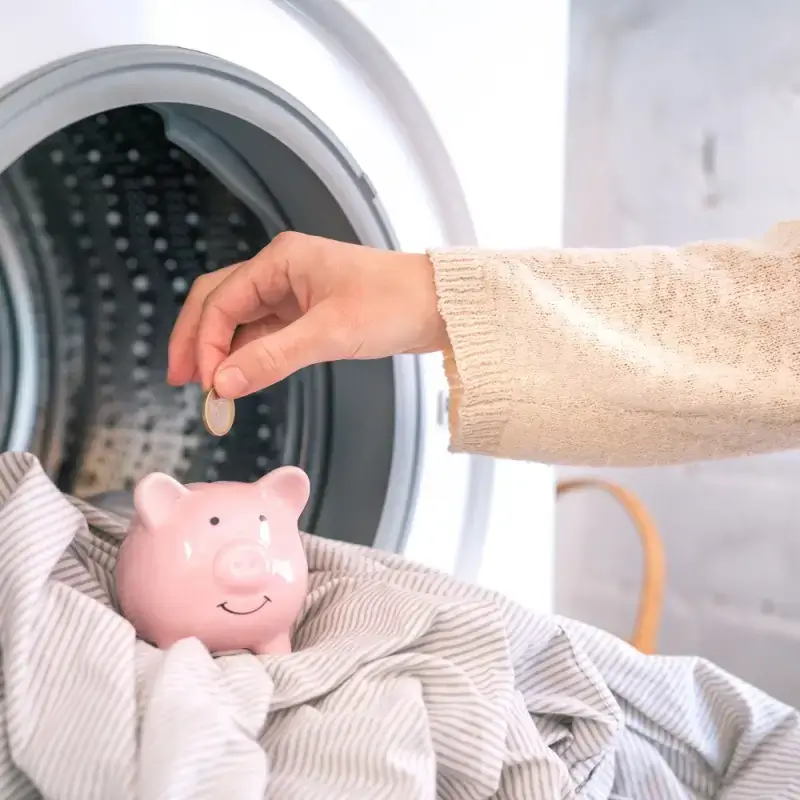Home / Compare Electricity &… / A guide to energy effici…

Key takeaways
- Switching to an appliance with greater energy efficiency can help you save on your electricity bills.
- Most electricity and some gas appliances have a star label that rates the energy efficiency of the product.
- The higher the energy rating, the more expensive an appliance may be but you’ll pay less in usage costs.
Understanding energy efficient appliances and their ratings
Did you know your appliances may account for a quarter of your home energy use?1 Fortunately, there are two fairly simple ways you may be able to increase your energy savings: buying the right energy-rated appliances and using them efficiently. We’ll take you through how to do both.
What are energy efficient appliances?
Energy efficient appliances refer to appliances that have a high energy efficiency rating, meaning they consume less energy than their counterparts. By getting energy efficient appliances you may save money on your electricity bills. Replacing old appliances with heavy energy usage like washing machines, dryers or dishwashers with more energy efficient ones can result in significant savings.
How to pick an energy efficient appliance
When purchasing a new appliance, cost is almost always a deciding factor, but bear in mind that the Water Efficiency Labelling and Standards (WELS) and Energy Rating Label may be helpful indicators of an appliance’s ‘hidden’ cost (i.e. its running costs).
Although you may save money upfront on the price of the machine, a lower star rating will indicate lower efficiency. Consequently, cheaper appliances may cost you more in the long run than more energy-efficient appliances.
Consider choosing a device with a higher efficiency rating but be aware that the disadvantage of energy-efficient appliances is that they may be more expensive than other options. To help with the cost, consider checking whether your state or territory is offering any rebates for energy-efficient appliances.
Are there energy appliance rebates or incentives?
Depending on where you live, there may be government rebates to help you upgrade your electrical appliances to more energy efficient models. For example, the Victorian Energy Upgrades (VEU) program may offer rebates for the cost of installing energy efficient appliances or other upgrades such as clothes dryers, heating and cooling systems, and more.2
Other rebates may be available depending on your location and whether you meet the eligibility requirements. Some rebates may require you to be signed up with a specific retailer.
Energy Rating
The Energy Rating Label is a government scheme for rating the energy efficiency (and therefore running costs) of household appliances in Australia.3 Appliances are sold with a label displaying their Australian Energy Star Rating, which indicates the energy efficiency of appliances and usage compared to similar models.
Energy usage is usually measured in kilowatt-hours (kWh) per year, which can give you an idea of the amount of energy an appliance will use in a year. The lower the kWh per year, the lower your energy usage, which should equal lower electricity bills.
The higher the star rating, the more efficient and cost-effective the appliance may be, which is the main advantage of energy-efficient appliances. Most energy ratings on appliances will have a star rating between one and six, but some of the most energy-efficient appliances can even be rated out of 10 stars.
The following home appliances must be sold with Energy Rating Labels:
- Air conditioners (non-ducted)
- Clothes dryers
- Computer monitors
- Dishwashers
- Freezers
- Pool pumps
- Refrigerators
- Televisions
- Washing machines.3
Water Efficiency Labelling and Standards (WELS)
Appliances like dishwashers and washing machines may have two labels. One is the Energy Rating Label, while the other is the WELS label, which rates the water efficiency of an appliance. Like the Energy Rating Label, WELS ratings are between one and six stars, and more stars equal better water efficiency.
Appliances that are sold with WELS rating stickers include:
- Dishwashers
- Flow controllers
- Showers
- Taps
- Toilets
- Urinals
- Washing machines.4
Gas Energy Rating Label
Unlike the Energy Rating and WELS labels, the Gas Energy Rating Label is not part of the Equipment Energy Efficiency (E3) Program, but gas appliances are still required to have a label as part of the product certification process.5 You’ll find these labels on:
- Ducted heating systems
- Space heaters
- Water heaters.6
Gas rating labels have six stars (the more stars, the more efficient) and display the gas appliance’s estimated annual gas consumption.
How to choose and effectively use energy-efficient appliances
Televisions

Choosing an energy efficient television:
- Usually, larger screens require more energy, so consider your needs and select the most efficient size.
- LEDs generally use less energy than plasma screens.
- Choose a TV that allows you to adjust brightness and contrast settings. Reducing the brightness will reduce the amount of power needed to generate the picture.
Tips for using it efficiently:
- Turn off televisions at the wall since standby mode still draws power.
- Don’t have a TV on in the background if you aren’t watching it.
- Turn off non-essential equipment when not in use (e.g. gaming consoles).
Computer monitors
Choosing an energy efficient computer monitor:
- Like televisions, size matters when it comes to computer monitors, as smaller screens are typically the most energy efficient.
- LCD or LED computer monitors are now the norm and also the most efficient.
Tips for using it efficiently:
- Power down when not in use; standby power can add to your electricity bill.
- Turn off all appliances at the outlet when not in use or when you’re away from home for extended periods, so you can avoid paying for electricity you’re not using.
Refrigerators and freezers
Choosing an energy efficient fridge and freezer:
- Choose the right size fridge/freezer. A fridge between 250 and 380 litres is usually sufficient for a household of one to two people.1 A fridge with a capacity of 350 to 530 litres is typically ideal for three to four people, while five or more people would benefit from a 440+ litre capacity.
- If you’ve left the door ajar, models with door alarms can alert you.
- Chest freezers are generally more efficient than upright freezers, so if you’re in the market for a separate, energy-efficient freezer, try looking at a chest freezer instead.8
Tips for using it efficiently:
- Don’t use an extra fridge or freezer unless necessary. If you have a bar fridge, but it’s only used intermittently, empty it and only plug it in when required.
- Keep your fridge thermostat between 3°C and 4°C and your freezer between -15°C and -18°C.9 Each degree you decrease the temperature, you use up to 5% more energy.1
- Make sure there’s sufficient airflow in your fridge. Keep items a few centimetres away from the back, sides and top and never place items directly in front of the ventilation system.
- Position your fridge/freezer out of direct sunlight and away from ovens, cooktops and dishwashers.
- Let hot items cool before putting them in the fridge/freezer (but don’t leave them out too long, as it’s a health risk).
- Never stack unfrozen items in the freezer; give them space to freeze and rearrange them as necessary.
- Maintain door seals and repair/replace them as appropriate.
Washing machines
Choosing an energy efficient washing machine:
- Make sure any washing machine you choose has the option of a cold-water cycle.
- How your washer heats water is also a consideration; consider opting for models that offer both hot- and cold-water inputs (instead of one input with an internal heating element that uses large amounts of power).
- Front loaders generally use less water, detergent and power, so consider opting for one of these over a top loader.1
- Check for models with ‘load sensing’ technology; these will check the size of the washing load and adjust water amounts, wash cycles and spin times accordingly.
- If you have an off-peak tariff, look for models with delay start functions so that you can set the washing to come on during off-peak times when power rates are often reduced. Likewise, if you have solar power, a delay start function can time your appliances to run during the day when it’s sunniest.
Tips for using it efficiently:
- Wash your clothes in cold water when possible as it can reduce your household energy usage.1
- If available, use the quick wash or economy cycle (there are even washing liquids that are specially formulated for fast/economy wash cycles).
- Separate your clothes by fabric weights, colours and dirt level. You may only need to wash delicates for a shorter time, so there’s no point tossing them in with heavy, sweaty workout gear.
- Always wash a full load instead of several smaller loads.
Clothes dryers
Choosing an energy efficient dryer:
- Consider different types of dryers. A traditional (vented) dryer is cheaper upfront but is less efficient and may cost more to run, so these are generally suited to those who rarely use a dryer (e.g. small households and those in warmer climates).1 The more heavy-duty appliances (condenser and heat pump dryers) may initially be expensive. Still, their low running cost and higher energy rating suit large households or frequent dryer users.
- Don’t forget to refer to the Energy Rating Label. It’s not all about the stars – the label will also tell you the annual energy consumption of the appliance.
Tips for using your appliance efficiently:
- Hang your clothes out to dry as often as possible. Clothes dryers are huge contributors to energy costs, but the sun is free!
- Run the clothes dryer on a medium rather than high temperature and don’t overload the dryer.
- Don’t mix heavy clothing with lighter clothing, as they have different drying times, and combining them will lengthen your overall drying time.
- Try to partially dry your clothes outside and then pop them into the dryer to finish; less time in the dryer means less energy consumed and lower bills.
- Clean your lint filter after every load to ensure maximum airflow and operating efficiency – and to reduce the risk of a fire!
Dishwashers
Choosing an energy efficient dishwasher:
- Like washing machines, choose a dishwasher with an economy setting and dual hot and cold water connections (to capitalise on energy-efficient hot water systems such as solar, gas and off-peak).
- Try to select a dishwasher with at least a 3.5-star Energy Rating and water rating, and an easily accessible filter for regular maintenance.
Tips for using it efficiently:
- Don’t wash half loads; only run your dishwasher when full.
- Choose your cycle wisely; lower temperature cycles with shorter times are more efficient.
- If allowed by your appliance (check the operating manual), open the dishwasher door and let your dishes air dry instead of going through the drying cycle.
- Follow all recommendations for dishwasher maintenance and clean filters regularly.
Air conditioners
Choosing an energy efficient air conditioner:
- Make sure the size of your system is suitable for the size of your room(s). Units that are too small for an area will constantly run without cycling off, which may be expensive, and units that are too large will waste energy. The right size unit for your space will depend on several factors (like your wall material and insulation), so having a professional help you choose is a good idea.7
- New, non-ducted household air conditioners will have a Zoned Energy Rating Label so you can compare appliances that are effective in your climate zone.7
- Portable air conditioners aren’t as efficient as fixed systems (split or ducted),8 so consider installing fixed air conditioning systems instead.
Tips for using it efficiently:
- Set the temperature between 18°C and 20°C in winter9 and 25°C and 27°C in summer10; these are the optimum temperature settings for comfort and operating efficiency.
- If you have a reverse cycle system, ensure all doors and windows are closed so that you aren’t heating/cooling rooms unnecessarily or letting heat/cool escape.
- In warmer weather, anticipate the weather and turn on your air conditioning early, as it operates more efficiently at moderate temperatures before your house heats up.
- Where possible, install your air-conditioner compressor unit in a shady spot with good airflow.
- Maintain your air conditioner regularly and always follow the filter cleaning instructions.
Ducted gas heating
Choosing energy efficient heating:
- As well as the gas rating, consider the R-value of the system (indicating the level of insulation on the ductwork).11 You should aim for a system with an R-value of 1.0 or higher.
- If you can, get a ducted heating system with zoning capabilities. This means you can potentially save money and energy by heating just the areas you need rather than your whole house.
Tips for using it efficiently:
- Set the temperature between 18°C and 20°C; every one degree higher than this can add an extra 10% to your energy bill.11
- Clean the return air grille’s filter once a month during the cold months (when you use your heater most), and service the gas furnace every two years to keep it running efficiently.
Meet our energy expert, Meredith O’Brien
As the Head of Energy at Compare the Market, Meredith O’Brien believes in educating Australian customers about the everchanging gas and electricity market so they can adjust their energy usage habits and get the most out of their energy plans.
Meredith has six years within the energy industry, following 15 years of experience in financial services and is currently studying a Master of Business Administration. Meredith is a dedicated customer advocate who is passionate about empowering Australians to find the right products to suit their needs by removing the confusion from comparing.
1 Australian Government: Department of Industry, Science, Energy and Resources. Appliances. Accessed November 2024.
2 Australian Government: Department of Industry, Science, Energy and Resources. Victorian Energy Upgrades for households. Accessed November 2024.
3 Energy Rating. Understanding the Energy Rating Label. Accessed November 2024.
4 Water Rating. Water rating label. Last updated April 2023. Accessed November 2024.
5 Australian Government: Department of Industry, Science, Energy and Resources. Energy ratings. Accessed November 2024.
6 Australian Government: Energy Made Easy. Efficient appliances. Last updated October 2023. Accessed November 2024.
7 Energy Rating. Heating and Cooling. Accessed November 2024.
8 Australian Government: Department of Industry, Science, Energy and Resources. Heating and Cooling. Accessed November 2024.
9 Australian Government: Department of Industry, Science, Energy and Resources. Winter energy savings. Accessed November 2024.
10 Australian Government: Department of Industry, Science, Energy and Resources. Design for your climate and keep cool. Accessed November 2024.
11 Sustainability Victoria. Choosing the right heating system for your home. Last updated January 2024. Accessed November 2024.



